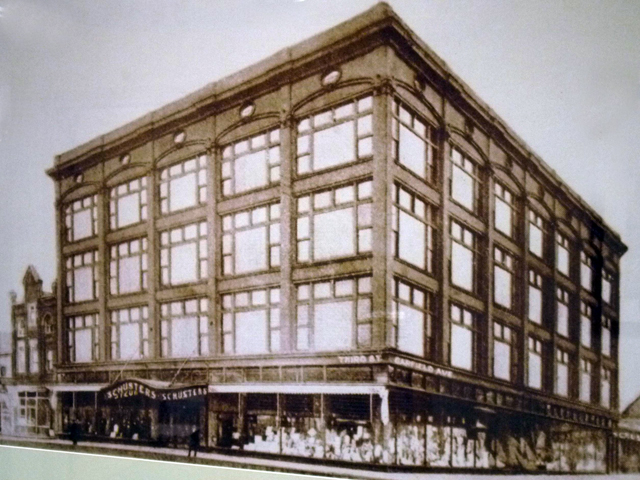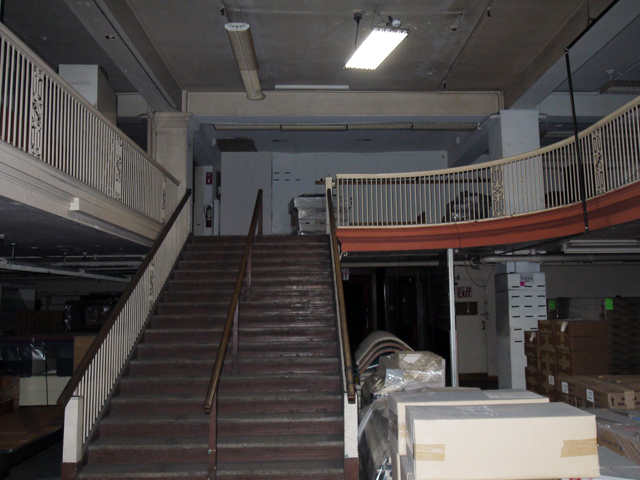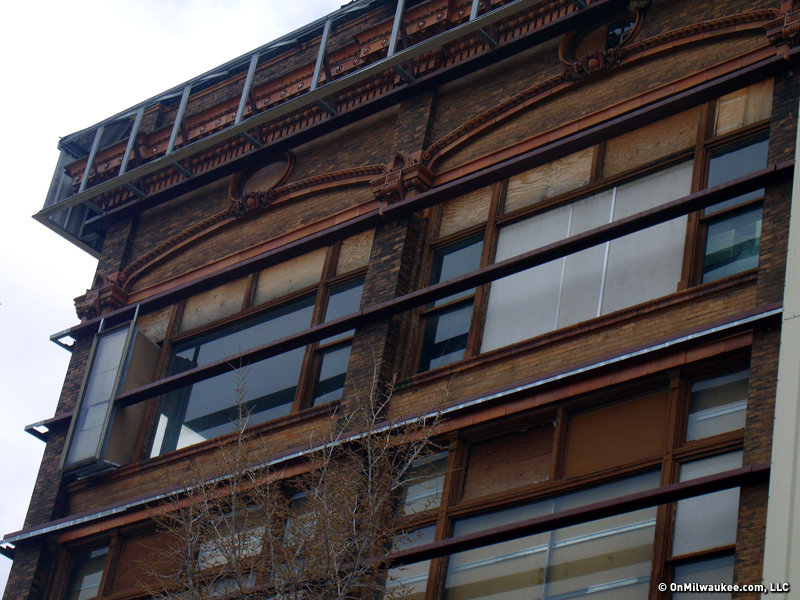If you haven’t yet gone over to 2151 N. King Dr. to get a peek at the beautiful four-story Chicago commercial style building that Kirchhoff & Rose designed for legendary Milwaukee department store, Schuster’s, don’t hesitate too long.
Edward Schuster got his start on the southwest corner of 3rd and Brown when he opened a store there in 1884. Business was strong enough that Schuster’s paid a whopping $140,000 to erect the current Kirchhoff & Rose building two decades later further up 3rd Street. That’s a cool couple million, at least, in today’s money.

A $200,000 addition, designed by Brust, Philipp and Heimerl, went up to the west around 1913 and another was constructed to the south in the late 1940s, not long before Gimbels bought Schuster’s in 1962. Some smaller additions were also made in the intervening years.
For decades, Schuster's was a Milwaukee mainstay – THE place to do your shopping. Michael Coakley, managing partner of CH Coakley & Co. – which owns the building – describes this flagship location as "a 470,000-square foot department store that was the precursor to Mayfair Mall and Brookfield Square. This is where everyone came" – an opinion that is supported by this photo.

Courtesy of CH Coakley & Co.
Schuster's had a number of Milwaukee locations, including shops on 12th and Vliet, and on Mitchell Street, among others. After the Gimbels deal, the stores operated as Gimbels-Schusters until 1969.
The King Drive (then called 3rd Street) store closed in August 1970, and was used for storage by the department store in the following years.
"Over the past several years our customers gradually have been transferring their business from 3rd Street to our other stores," Leonard C. Hobert, president of Gimbels' Wisconsin stores, told the Milwaukee Journal, which pointed to the 1967 riots as a major factor in declining commerce on the once-bustling thoroughfare.
"This decreasing volume for some time has been well below the levels needed to maintain our 3rd Street operation, which in turn makes this decision necessary."
The paper also noted demographic shifts as a factor, writing, "the deterioration actually began after World War II with the construction of shopping centers in outlying areas. The exodus to the suburbs also was underway."
In 1984, the building was wrapped in insulation and metal sheathing that obscured its facade but helped slash utility costs. By then the building served as a Gimbel’s warehouse and the Schuster’s name was but a memory.
Thanks to the sheathing, the stunning masonry of the building also faded into the recesses of our collective memory.
So, it was a revelation when some of the cream-colored metal panels began to come down in recent weeks. Beneath, there were the broad windows that mark the Chicago commercial style, and some neoclassical details, too.

Above the windows on the fourth floor are eight-pane oval oculi capping ornate decorative terra cotta arches that span the larger (original) window frames. The building’s attractive cornice remains, as does other decorative terra cotta ornament.
"The historian looked at our building and said, ‘This is quite remarkable,’" says Coakley, whose company purchased the building in 1992 for around $350,000.
Coakley says that the masonry – by Raule Contractors – was protected for the past 30 years by the metal covering, pieces of which were removed so that Coakley could see what was underneath.
Now that Coakley has been able to assess exactly what’s beneath the sheathing and the condition of the facade, the metal will soon go back up while plans for the buildings' redevelopment are solidified.

While we stand in the northwest corner of the 1913 addition, looking out over the neighborhoods through the big windows, Coakley talks about the future of the complex – Coakley owns the entire square block, plus some more across Garfield Avenue to the north – as he sees it.
"This is the strong neighborhood of Halyard Park," he says, gesturing to the west, "and this is the strong, strong neighborhood of Brewers' Hill. You've got two powerful neighborhoods surrounding us. Ultimately the goal would be to (shift) this warehouse and distribution center, my operation center, from here to one of my other eight buildings, and convert this building."
Inside the huge building, we snap photos of those stunning oculi, hear the sound of our footsteps on the weathered hardwood floors, wonder at the original window display cases and wood-framed revolving door, and climb the steps up to the mezzanine to check out the iron railings.

Some of the 18-foot columns in the original building’s first-floor retail space still have their capitals and there’s another old entrance extant on the King Drive side, this one nodding at Moderne with its polished aluminum framing.

Even if you exclude the string of low-rise retail and office buildings that Coakley owns to the south, these three large structures are huge and the possibilities seem almost endless.
At the moment Coakley appears to be leaning toward office space, with perhaps some street-level retail and some housing on the upper floors.
Coakley is working with Plunkett Raysich Architects LLP on the project.
"To renovate a building of this size is real dollars and cents. So it's important that we get this right," says Coakley.
"The mayor and Ald. Coggs are very supportive. They realize how important this building is for the continued transformation of Milwaukee and this area."

Coakley sees his buildings as a key part in development plans in the area, which include a new mixed-use project being developed by Maures Development Group across the street at the former Garfield Avenue School.
"I think we're joined, literally at the hip: as we go, they go," he says. "As you know Milwaukee's been expanding and can't go east because of the lake, west is the freeway. There's been such great success, you know, at the old Schlitz Park, Manpower and Time Warner, and now a billion-dollar sports complex right there as well, with the Bucks.

"I think that this neighborhood needs a game changer. If we converted this building over into mixed-use retail and commercial office moving, I think that's going to actually promote a lot of retail to come around this area. We're tied directly with the school and Bronzeville."
The next step, Coakley says, is to work with a range of partners, including the King Drive BID, the City and others, to formulate a plan. And while that happens, the siding will be back up, but with an eye toward ultimately pulling it all off for good soon.
"We actually have now a very good feel for what it's going to take to convert this building," Coakley says. "So, we're putting the siding back on. You can see the insulation thickness, and you can see how wonderful that insulation and the siding is for the building to keep the brick intact. You can imagine what that does for my heating bills.
"But we're taking steps to move forward, and this journey continues on."
Born in Brooklyn, N.Y., where he lived until he was 17, Bobby received his BA-Mass Communications from UWM in 1989 and has lived in Walker's Point, Bay View, Enderis Park, South Milwaukee and on the East Side.
He has published three non-fiction books in Italy – including one about an event in Milwaukee history, which was published in the U.S. in autumn 2010. Four more books, all about Milwaukee, have been published by The History Press.
With his most recent band, The Yell Leaders, Bobby released four LPs and had a songs featured in episodes of TV's "Party of Five" and "Dawson's Creek," and films in Japan, South America and the U.S. The Yell Leaders were named the best unsigned band in their region by VH-1 as part of its Rock Across America 1998 Tour. Most recently, the band contributed tracks to a UK vinyl/CD tribute to the Redskins and collaborated on a track with Italian novelist Enrico Remmert.
He's produced three installments of the "OMCD" series of local music compilations for OnMilwaukee.com and in 2007 produced a CD of Italian music and poetry.
In 2005, he was awarded the City of Asti's (Italy) Journalism Prize for his work focusing on that area. He has also won awards from the Milwaukee Press Club.
He has be heard on 88Nine Radio Milwaukee talking about his "Urban Spelunking" series of stories, in that station's most popular podcast.







